Communication Issues in Palliative Care: A Case Study
VerifiedAdded on 2023/01/11
|8
|2110
|2
AI Summary
This case study explores the communication issues in palliative care, focusing on a patient with advanced lung cancer. It discusses the challenges in maintaining patient autonomy and the importance of effective communication in end-of-life care. The study also highlights the need for culturally appropriate communication and ethical considerations in advanced care planning.
Contribute Materials
Your contribution can guide someone’s learning journey. Share your
documents today.
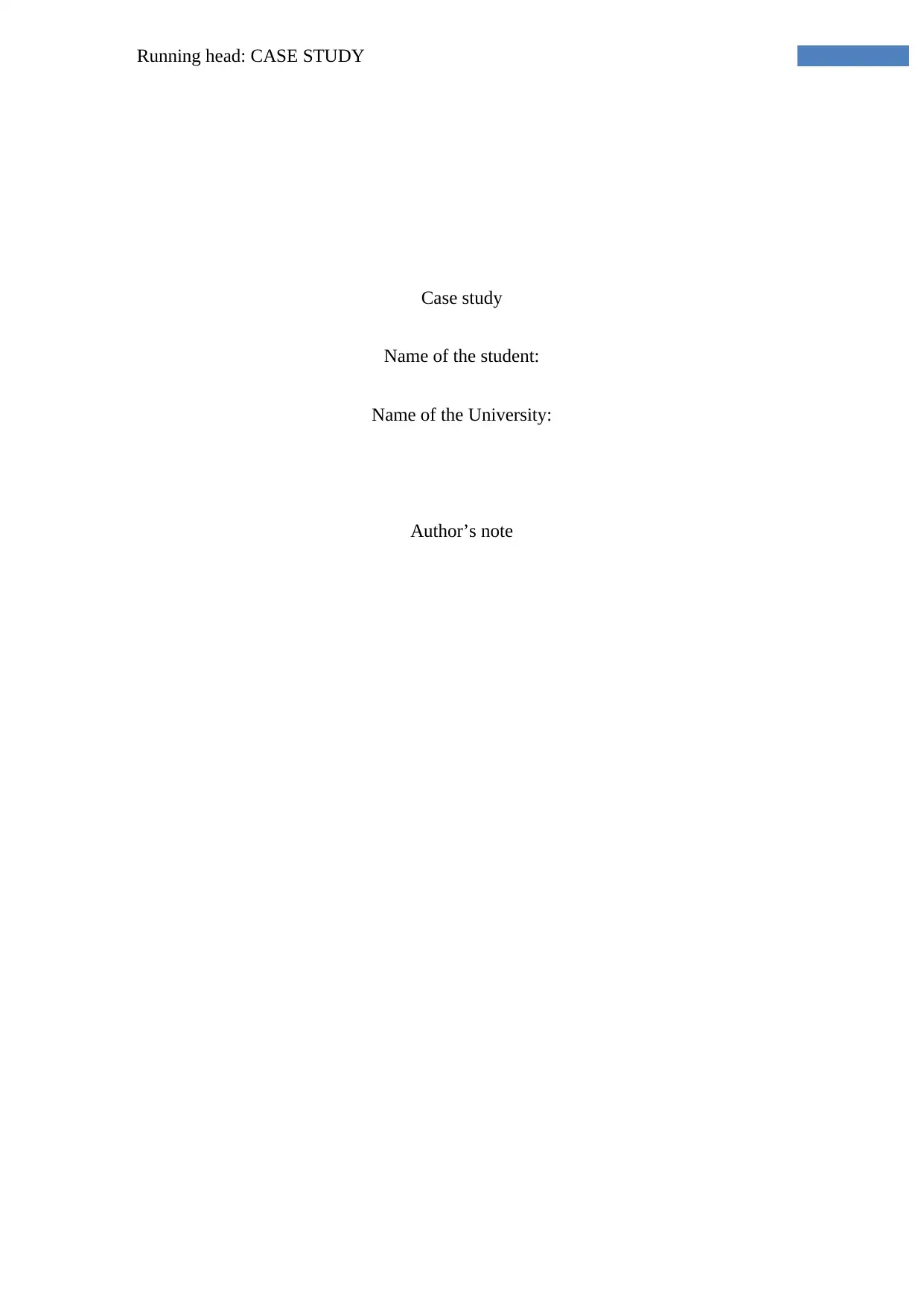
Running head: CASE STUDY
Case study
Name of the student:
Name of the University:
Author’s note
Case study
Name of the student:
Name of the University:
Author’s note
Secure Best Marks with AI Grader
Need help grading? Try our AI Grader for instant feedback on your assignments.
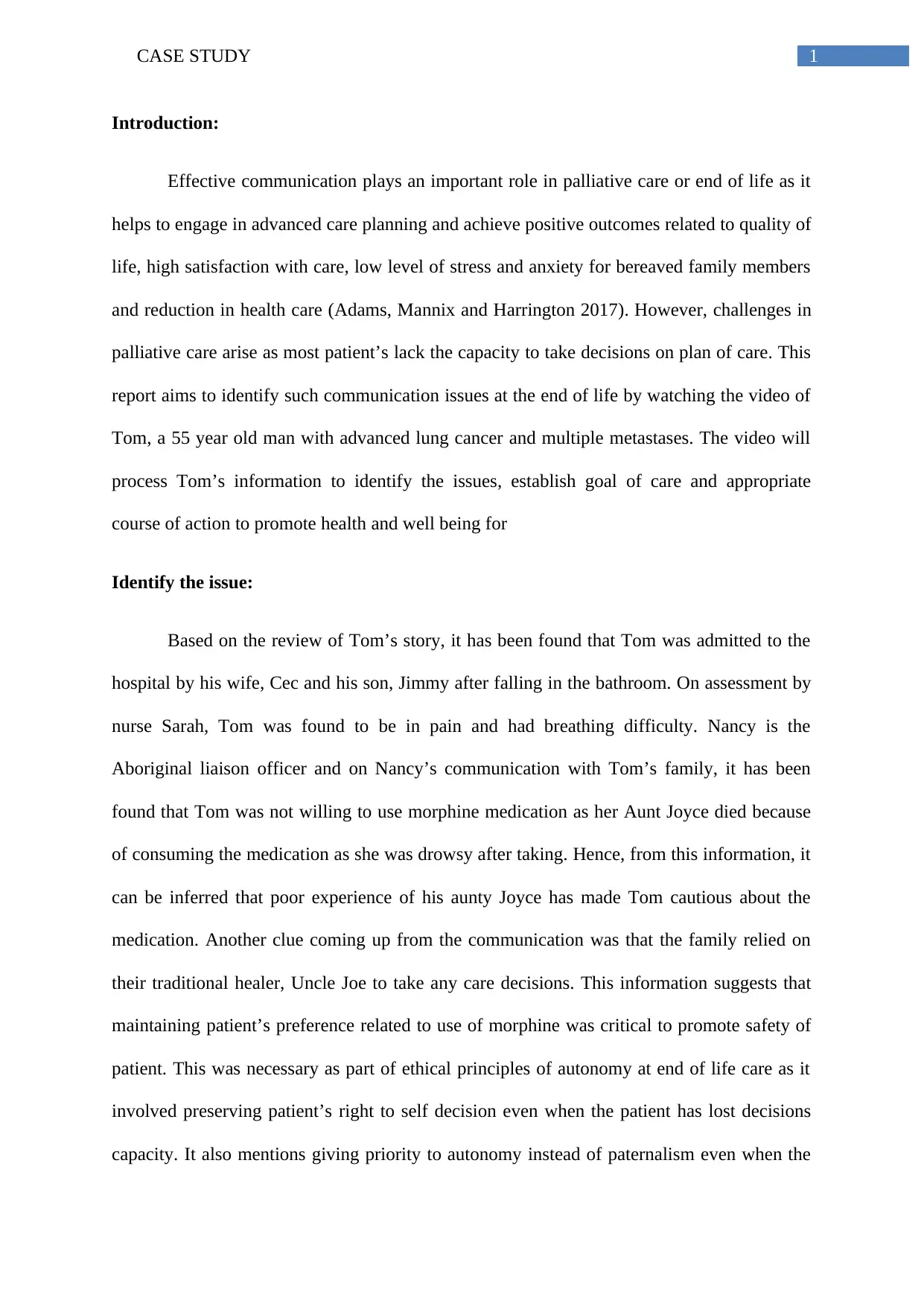
1CASE STUDY
Introduction:
Effective communication plays an important role in palliative care or end of life as it
helps to engage in advanced care planning and achieve positive outcomes related to quality of
life, high satisfaction with care, low level of stress and anxiety for bereaved family members
and reduction in health care (Adams, Mannix and Harrington 2017). However, challenges in
palliative care arise as most patient’s lack the capacity to take decisions on plan of care. This
report aims to identify such communication issues at the end of life by watching the video of
Tom, a 55 year old man with advanced lung cancer and multiple metastases. The video will
process Tom’s information to identify the issues, establish goal of care and appropriate
course of action to promote health and well being for
Identify the issue:
Based on the review of Tom’s story, it has been found that Tom was admitted to the
hospital by his wife, Cec and his son, Jimmy after falling in the bathroom. On assessment by
nurse Sarah, Tom was found to be in pain and had breathing difficulty. Nancy is the
Aboriginal liaison officer and on Nancy’s communication with Tom’s family, it has been
found that Tom was not willing to use morphine medication as her Aunt Joyce died because
of consuming the medication as she was drowsy after taking. Hence, from this information, it
can be inferred that poor experience of his aunty Joyce has made Tom cautious about the
medication. Another clue coming up from the communication was that the family relied on
their traditional healer, Uncle Joe to take any care decisions. This information suggests that
maintaining patient’s preference related to use of morphine was critical to promote safety of
patient. This was necessary as part of ethical principles of autonomy at end of life care as it
involved preserving patient’s right to self decision even when the patient has lost decisions
capacity. It also mentions giving priority to autonomy instead of paternalism even when the
Introduction:
Effective communication plays an important role in palliative care or end of life as it
helps to engage in advanced care planning and achieve positive outcomes related to quality of
life, high satisfaction with care, low level of stress and anxiety for bereaved family members
and reduction in health care (Adams, Mannix and Harrington 2017). However, challenges in
palliative care arise as most patient’s lack the capacity to take decisions on plan of care. This
report aims to identify such communication issues at the end of life by watching the video of
Tom, a 55 year old man with advanced lung cancer and multiple metastases. The video will
process Tom’s information to identify the issues, establish goal of care and appropriate
course of action to promote health and well being for
Identify the issue:
Based on the review of Tom’s story, it has been found that Tom was admitted to the
hospital by his wife, Cec and his son, Jimmy after falling in the bathroom. On assessment by
nurse Sarah, Tom was found to be in pain and had breathing difficulty. Nancy is the
Aboriginal liaison officer and on Nancy’s communication with Tom’s family, it has been
found that Tom was not willing to use morphine medication as her Aunt Joyce died because
of consuming the medication as she was drowsy after taking. Hence, from this information, it
can be inferred that poor experience of his aunty Joyce has made Tom cautious about the
medication. Another clue coming up from the communication was that the family relied on
their traditional healer, Uncle Joe to take any care decisions. This information suggests that
maintaining patient’s preference related to use of morphine was critical to promote safety of
patient. This was necessary as part of ethical principles of autonomy at end of life care as it
involved preserving patient’s right to self decision even when the patient has lost decisions
capacity. It also mentions giving priority to autonomy instead of paternalism even when the
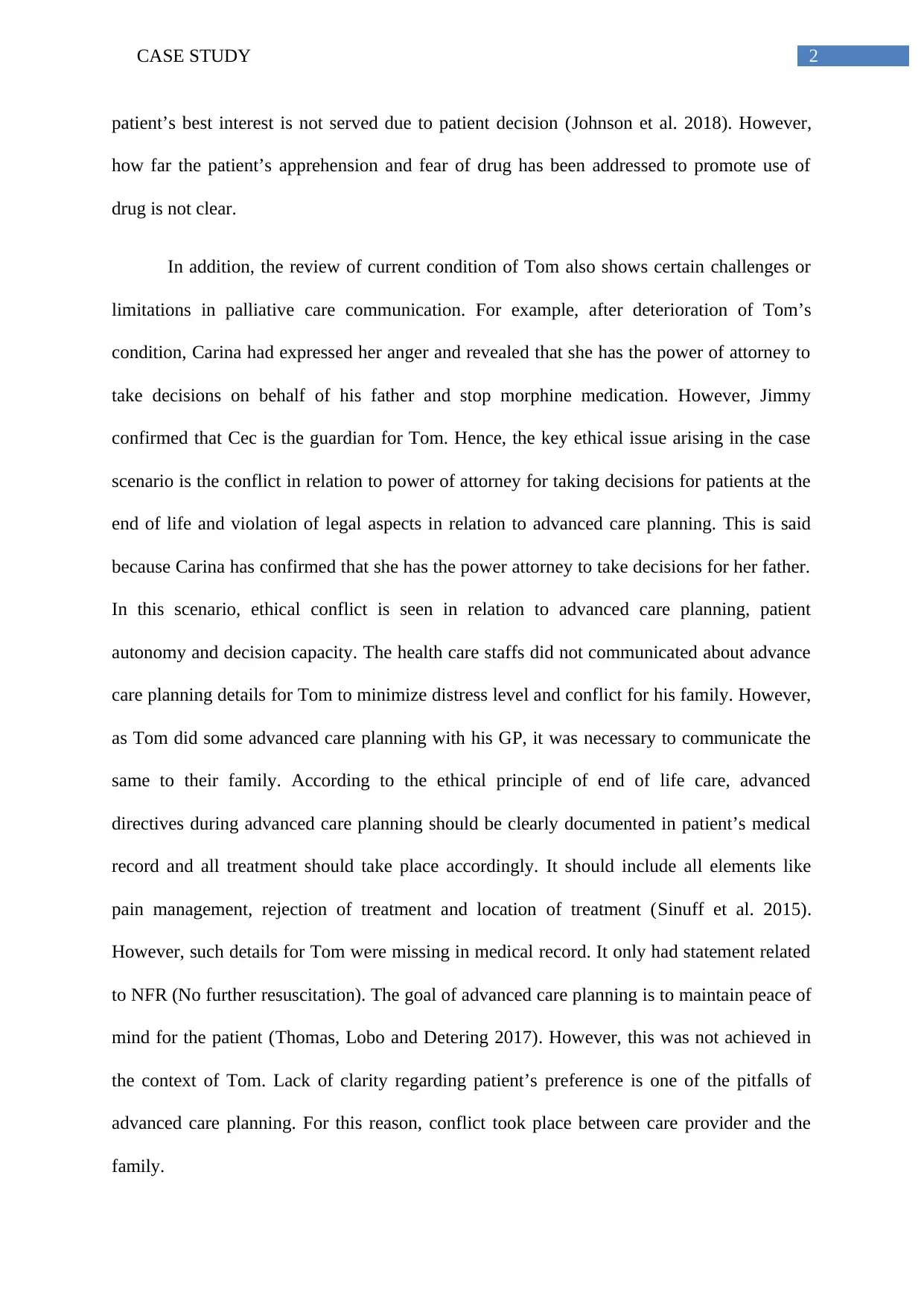
2CASE STUDY
patient’s best interest is not served due to patient decision (Johnson et al. 2018). However,
how far the patient’s apprehension and fear of drug has been addressed to promote use of
drug is not clear.
In addition, the review of current condition of Tom also shows certain challenges or
limitations in palliative care communication. For example, after deterioration of Tom’s
condition, Carina had expressed her anger and revealed that she has the power of attorney to
take decisions on behalf of his father and stop morphine medication. However, Jimmy
confirmed that Cec is the guardian for Tom. Hence, the key ethical issue arising in the case
scenario is the conflict in relation to power of attorney for taking decisions for patients at the
end of life and violation of legal aspects in relation to advanced care planning. This is said
because Carina has confirmed that she has the power attorney to take decisions for her father.
In this scenario, ethical conflict is seen in relation to advanced care planning, patient
autonomy and decision capacity. The health care staffs did not communicated about advance
care planning details for Tom to minimize distress level and conflict for his family. However,
as Tom did some advanced care planning with his GP, it was necessary to communicate the
same to their family. According to the ethical principle of end of life care, advanced
directives during advanced care planning should be clearly documented in patient’s medical
record and all treatment should take place accordingly. It should include all elements like
pain management, rejection of treatment and location of treatment (Sinuff et al. 2015).
However, such details for Tom were missing in medical record. It only had statement related
to NFR (No further resuscitation). The goal of advanced care planning is to maintain peace of
mind for the patient (Thomas, Lobo and Detering 2017). However, this was not achieved in
the context of Tom. Lack of clarity regarding patient’s preference is one of the pitfalls of
advanced care planning. For this reason, conflict took place between care provider and the
family.
patient’s best interest is not served due to patient decision (Johnson et al. 2018). However,
how far the patient’s apprehension and fear of drug has been addressed to promote use of
drug is not clear.
In addition, the review of current condition of Tom also shows certain challenges or
limitations in palliative care communication. For example, after deterioration of Tom’s
condition, Carina had expressed her anger and revealed that she has the power of attorney to
take decisions on behalf of his father and stop morphine medication. However, Jimmy
confirmed that Cec is the guardian for Tom. Hence, the key ethical issue arising in the case
scenario is the conflict in relation to power of attorney for taking decisions for patients at the
end of life and violation of legal aspects in relation to advanced care planning. This is said
because Carina has confirmed that she has the power attorney to take decisions for her father.
In this scenario, ethical conflict is seen in relation to advanced care planning, patient
autonomy and decision capacity. The health care staffs did not communicated about advance
care planning details for Tom to minimize distress level and conflict for his family. However,
as Tom did some advanced care planning with his GP, it was necessary to communicate the
same to their family. According to the ethical principle of end of life care, advanced
directives during advanced care planning should be clearly documented in patient’s medical
record and all treatment should take place accordingly. It should include all elements like
pain management, rejection of treatment and location of treatment (Sinuff et al. 2015).
However, such details for Tom were missing in medical record. It only had statement related
to NFR (No further resuscitation). The goal of advanced care planning is to maintain peace of
mind for the patient (Thomas, Lobo and Detering 2017). However, this was not achieved in
the context of Tom. Lack of clarity regarding patient’s preference is one of the pitfalls of
advanced care planning. For this reason, conflict took place between care provider and the
family.
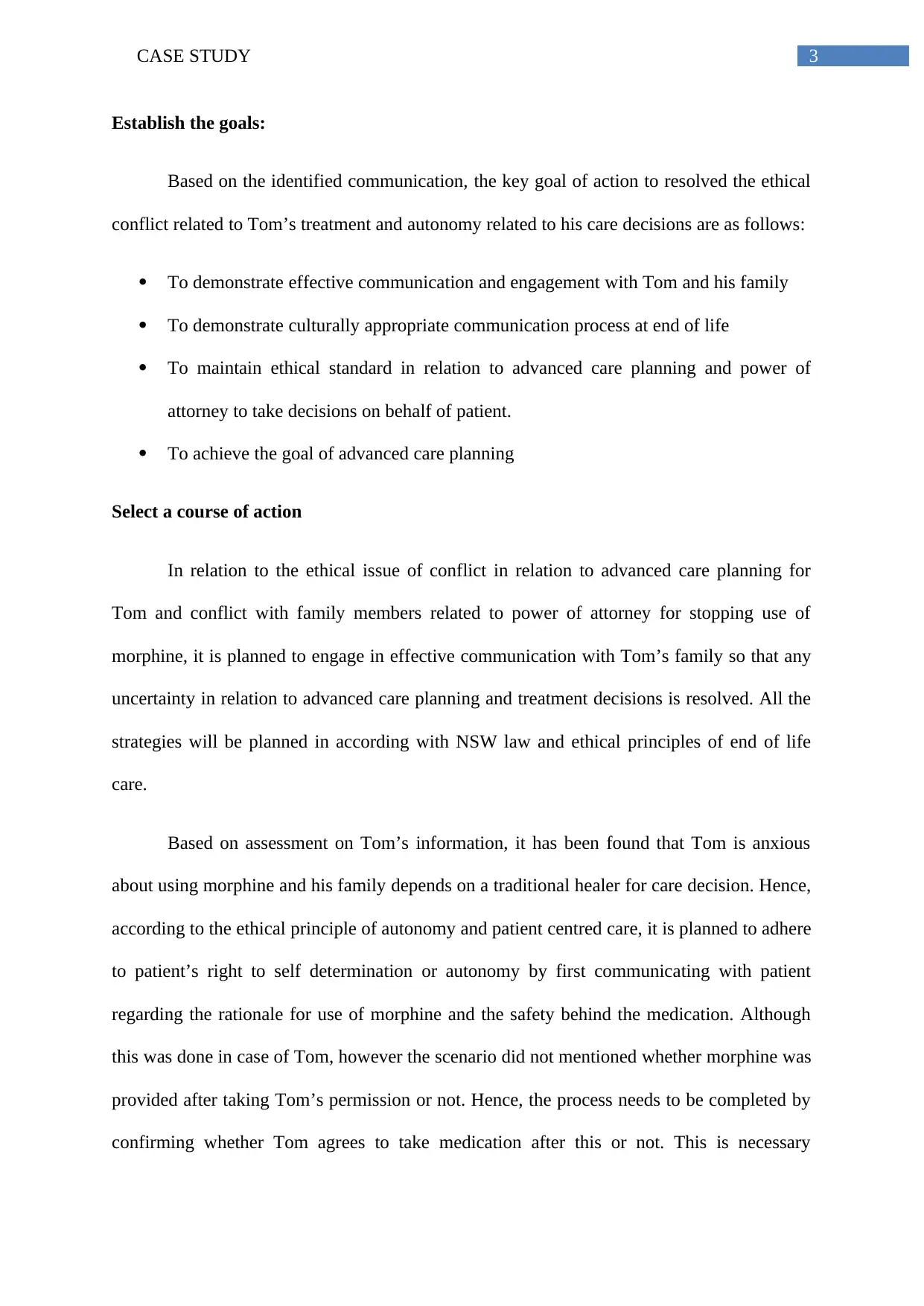
3CASE STUDY
Establish the goals:
Based on the identified communication, the key goal of action to resolved the ethical
conflict related to Tom’s treatment and autonomy related to his care decisions are as follows:
To demonstrate effective communication and engagement with Tom and his family
To demonstrate culturally appropriate communication process at end of life
To maintain ethical standard in relation to advanced care planning and power of
attorney to take decisions on behalf of patient.
To achieve the goal of advanced care planning
Select a course of action
In relation to the ethical issue of conflict in relation to advanced care planning for
Tom and conflict with family members related to power of attorney for stopping use of
morphine, it is planned to engage in effective communication with Tom’s family so that any
uncertainty in relation to advanced care planning and treatment decisions is resolved. All the
strategies will be planned in according with NSW law and ethical principles of end of life
care.
Based on assessment on Tom’s information, it has been found that Tom is anxious
about using morphine and his family depends on a traditional healer for care decision. Hence,
according to the ethical principle of autonomy and patient centred care, it is planned to adhere
to patient’s right to self determination or autonomy by first communicating with patient
regarding the rationale for use of morphine and the safety behind the medication. Although
this was done in case of Tom, however the scenario did not mentioned whether morphine was
provided after taking Tom’s permission or not. Hence, the process needs to be completed by
confirming whether Tom agrees to take medication after this or not. This is necessary
Establish the goals:
Based on the identified communication, the key goal of action to resolved the ethical
conflict related to Tom’s treatment and autonomy related to his care decisions are as follows:
To demonstrate effective communication and engagement with Tom and his family
To demonstrate culturally appropriate communication process at end of life
To maintain ethical standard in relation to advanced care planning and power of
attorney to take decisions on behalf of patient.
To achieve the goal of advanced care planning
Select a course of action
In relation to the ethical issue of conflict in relation to advanced care planning for
Tom and conflict with family members related to power of attorney for stopping use of
morphine, it is planned to engage in effective communication with Tom’s family so that any
uncertainty in relation to advanced care planning and treatment decisions is resolved. All the
strategies will be planned in according with NSW law and ethical principles of end of life
care.
Based on assessment on Tom’s information, it has been found that Tom is anxious
about using morphine and his family depends on a traditional healer for care decision. Hence,
according to the ethical principle of autonomy and patient centred care, it is planned to adhere
to patient’s right to self determination or autonomy by first communicating with patient
regarding the rationale for use of morphine and the safety behind the medication. Although
this was done in case of Tom, however the scenario did not mentioned whether morphine was
provided after taking Tom’s permission or not. Hence, the process needs to be completed by
confirming whether Tom agrees to take medication after this or not. This is necessary
Secure Best Marks with AI Grader
Need help grading? Try our AI Grader for instant feedback on your assignments.
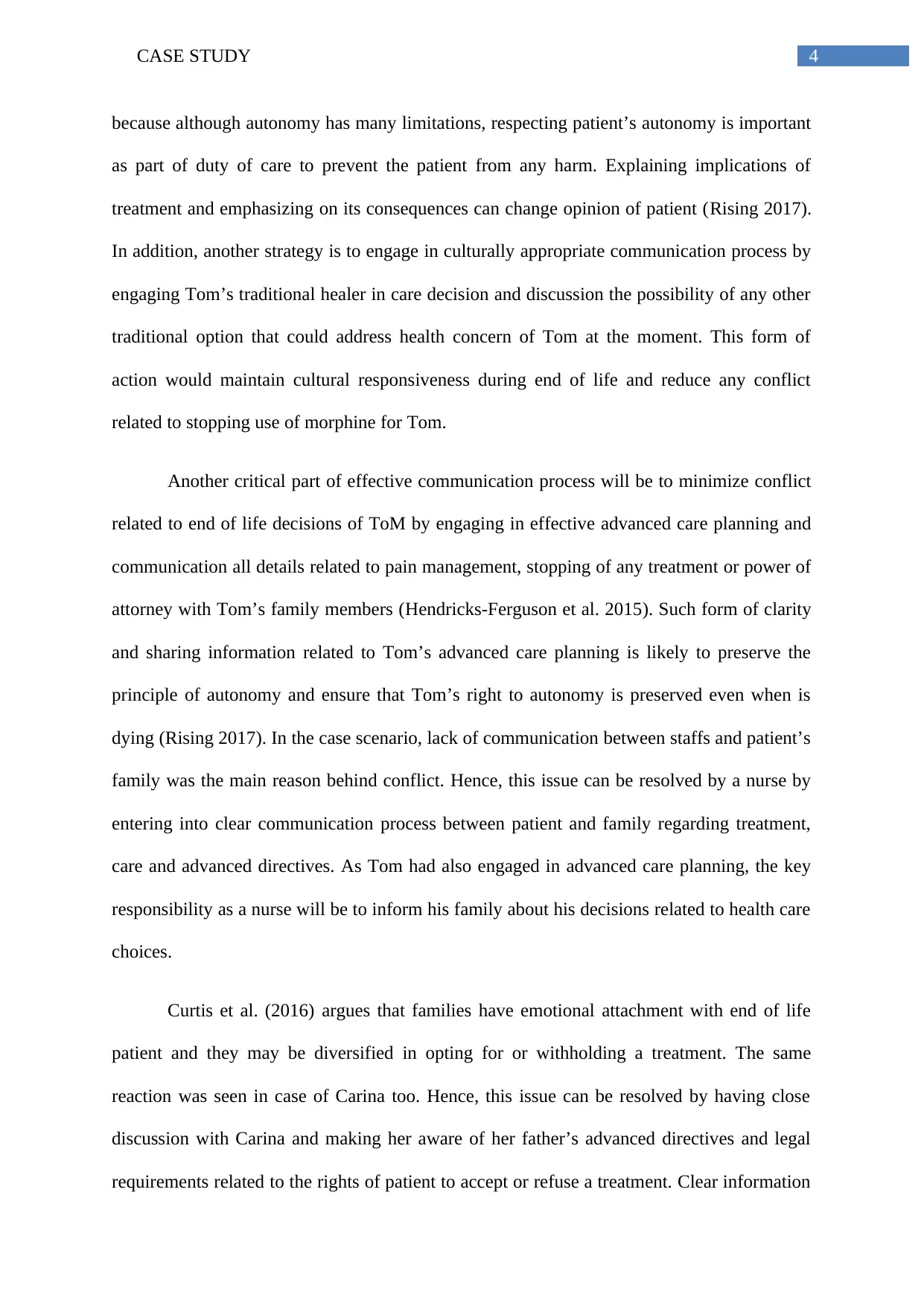
4CASE STUDY
because although autonomy has many limitations, respecting patient’s autonomy is important
as part of duty of care to prevent the patient from any harm. Explaining implications of
treatment and emphasizing on its consequences can change opinion of patient (Rising 2017).
In addition, another strategy is to engage in culturally appropriate communication process by
engaging Tom’s traditional healer in care decision and discussion the possibility of any other
traditional option that could address health concern of Tom at the moment. This form of
action would maintain cultural responsiveness during end of life and reduce any conflict
related to stopping use of morphine for Tom.
Another critical part of effective communication process will be to minimize conflict
related to end of life decisions of ToM by engaging in effective advanced care planning and
communication all details related to pain management, stopping of any treatment or power of
attorney with Tom’s family members (Hendricks-Ferguson et al. 2015). Such form of clarity
and sharing information related to Tom’s advanced care planning is likely to preserve the
principle of autonomy and ensure that Tom’s right to autonomy is preserved even when is
dying (Rising 2017). In the case scenario, lack of communication between staffs and patient’s
family was the main reason behind conflict. Hence, this issue can be resolved by a nurse by
entering into clear communication process between patient and family regarding treatment,
care and advanced directives. As Tom had also engaged in advanced care planning, the key
responsibility as a nurse will be to inform his family about his decisions related to health care
choices.
Curtis et al. (2016) argues that families have emotional attachment with end of life
patient and they may be diversified in opting for or withholding a treatment. The same
reaction was seen in case of Carina too. Hence, this issue can be resolved by having close
discussion with Carina and making her aware of her father’s advanced directives and legal
requirements related to the rights of patient to accept or refuse a treatment. Clear information
because although autonomy has many limitations, respecting patient’s autonomy is important
as part of duty of care to prevent the patient from any harm. Explaining implications of
treatment and emphasizing on its consequences can change opinion of patient (Rising 2017).
In addition, another strategy is to engage in culturally appropriate communication process by
engaging Tom’s traditional healer in care decision and discussion the possibility of any other
traditional option that could address health concern of Tom at the moment. This form of
action would maintain cultural responsiveness during end of life and reduce any conflict
related to stopping use of morphine for Tom.
Another critical part of effective communication process will be to minimize conflict
related to end of life decisions of ToM by engaging in effective advanced care planning and
communication all details related to pain management, stopping of any treatment or power of
attorney with Tom’s family members (Hendricks-Ferguson et al. 2015). Such form of clarity
and sharing information related to Tom’s advanced care planning is likely to preserve the
principle of autonomy and ensure that Tom’s right to autonomy is preserved even when is
dying (Rising 2017). In the case scenario, lack of communication between staffs and patient’s
family was the main reason behind conflict. Hence, this issue can be resolved by a nurse by
entering into clear communication process between patient and family regarding treatment,
care and advanced directives. As Tom had also engaged in advanced care planning, the key
responsibility as a nurse will be to inform his family about his decisions related to health care
choices.
Curtis et al. (2016) argues that families have emotional attachment with end of life
patient and they may be diversified in opting for or withholding a treatment. The same
reaction was seen in case of Carina too. Hence, this issue can be resolved by having close
discussion with Carina and making her aware of her father’s advanced directives and legal
requirements related to the rights of patient to accept or refuse a treatment. Clear information
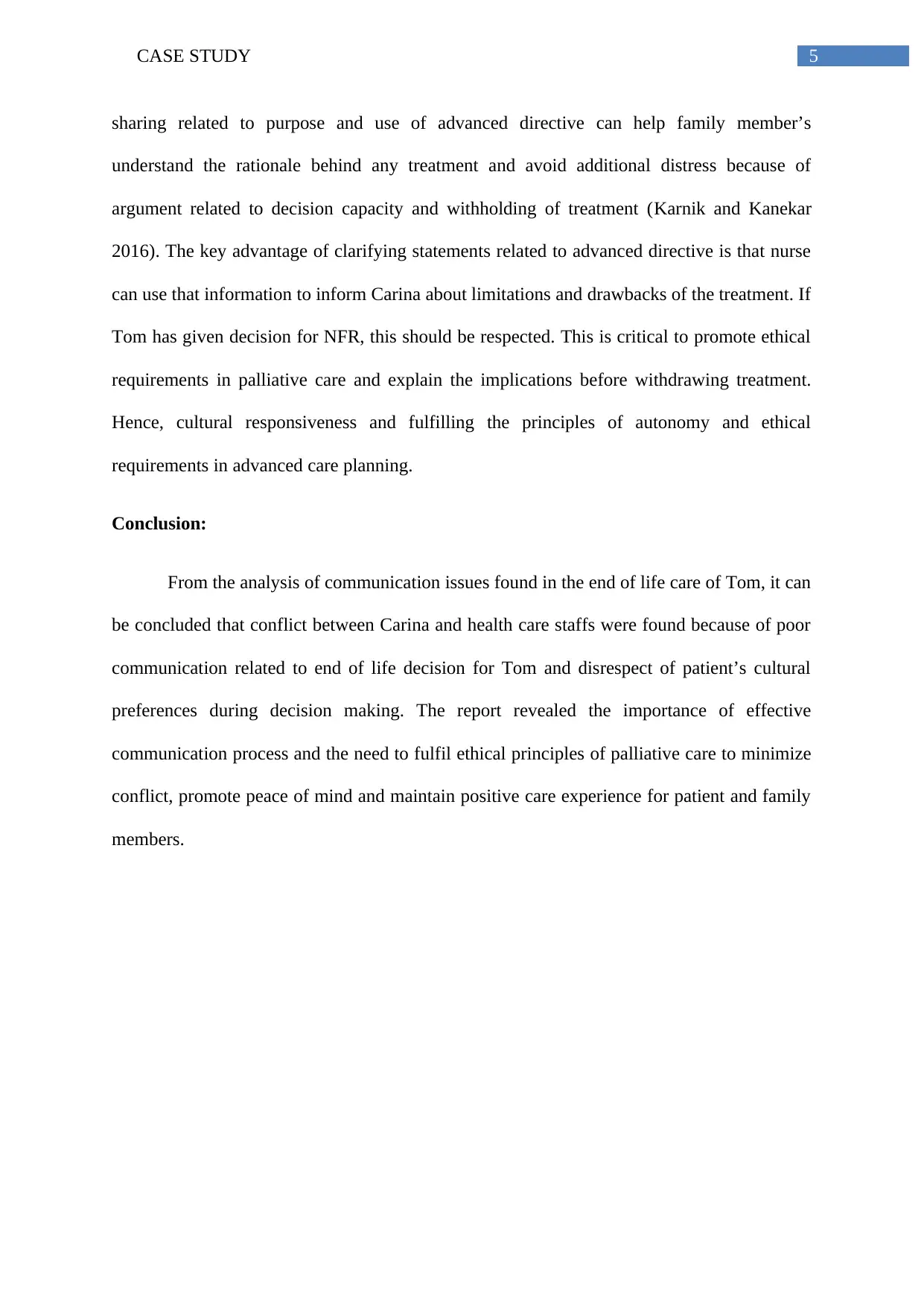
5CASE STUDY
sharing related to purpose and use of advanced directive can help family member’s
understand the rationale behind any treatment and avoid additional distress because of
argument related to decision capacity and withholding of treatment (Karnik and Kanekar
2016). The key advantage of clarifying statements related to advanced directive is that nurse
can use that information to inform Carina about limitations and drawbacks of the treatment. If
Tom has given decision for NFR, this should be respected. This is critical to promote ethical
requirements in palliative care and explain the implications before withdrawing treatment.
Hence, cultural responsiveness and fulfilling the principles of autonomy and ethical
requirements in advanced care planning.
Conclusion:
From the analysis of communication issues found in the end of life care of Tom, it can
be concluded that conflict between Carina and health care staffs were found because of poor
communication related to end of life decision for Tom and disrespect of patient’s cultural
preferences during decision making. The report revealed the importance of effective
communication process and the need to fulfil ethical principles of palliative care to minimize
conflict, promote peace of mind and maintain positive care experience for patient and family
members.
sharing related to purpose and use of advanced directive can help family member’s
understand the rationale behind any treatment and avoid additional distress because of
argument related to decision capacity and withholding of treatment (Karnik and Kanekar
2016). The key advantage of clarifying statements related to advanced directive is that nurse
can use that information to inform Carina about limitations and drawbacks of the treatment. If
Tom has given decision for NFR, this should be respected. This is critical to promote ethical
requirements in palliative care and explain the implications before withdrawing treatment.
Hence, cultural responsiveness and fulfilling the principles of autonomy and ethical
requirements in advanced care planning.
Conclusion:
From the analysis of communication issues found in the end of life care of Tom, it can
be concluded that conflict between Carina and health care staffs were found because of poor
communication related to end of life decision for Tom and disrespect of patient’s cultural
preferences during decision making. The report revealed the importance of effective
communication process and the need to fulfil ethical principles of palliative care to minimize
conflict, promote peace of mind and maintain positive care experience for patient and family
members.
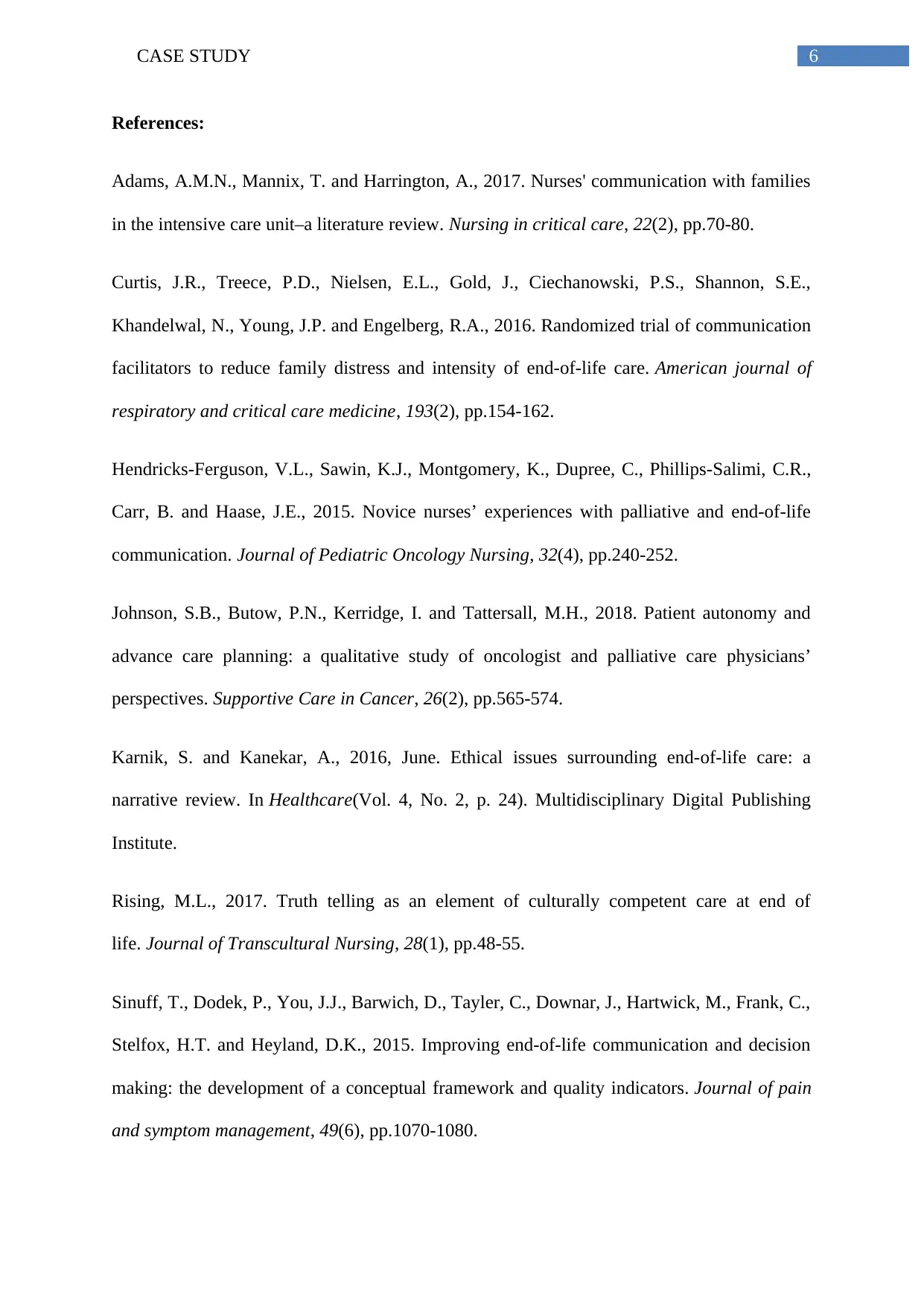
6CASE STUDY
References:
Adams, A.M.N., Mannix, T. and Harrington, A., 2017. Nurses' communication with families
in the intensive care unit–a literature review. Nursing in critical care, 22(2), pp.70-80.
Curtis, J.R., Treece, P.D., Nielsen, E.L., Gold, J., Ciechanowski, P.S., Shannon, S.E.,
Khandelwal, N., Young, J.P. and Engelberg, R.A., 2016. Randomized trial of communication
facilitators to reduce family distress and intensity of end-of-life care. American journal of
respiratory and critical care medicine, 193(2), pp.154-162.
Hendricks-Ferguson, V.L., Sawin, K.J., Montgomery, K., Dupree, C., Phillips-Salimi, C.R.,
Carr, B. and Haase, J.E., 2015. Novice nurses’ experiences with palliative and end-of-life
communication. Journal of Pediatric Oncology Nursing, 32(4), pp.240-252.
Johnson, S.B., Butow, P.N., Kerridge, I. and Tattersall, M.H., 2018. Patient autonomy and
advance care planning: a qualitative study of oncologist and palliative care physicians’
perspectives. Supportive Care in Cancer, 26(2), pp.565-574.
Karnik, S. and Kanekar, A., 2016, June. Ethical issues surrounding end-of-life care: a
narrative review. In Healthcare(Vol. 4, No. 2, p. 24). Multidisciplinary Digital Publishing
Institute.
Rising, M.L., 2017. Truth telling as an element of culturally competent care at end of
life. Journal of Transcultural Nursing, 28(1), pp.48-55.
Sinuff, T., Dodek, P., You, J.J., Barwich, D., Tayler, C., Downar, J., Hartwick, M., Frank, C.,
Stelfox, H.T. and Heyland, D.K., 2015. Improving end-of-life communication and decision
making: the development of a conceptual framework and quality indicators. Journal of pain
and symptom management, 49(6), pp.1070-1080.
References:
Adams, A.M.N., Mannix, T. and Harrington, A., 2017. Nurses' communication with families
in the intensive care unit–a literature review. Nursing in critical care, 22(2), pp.70-80.
Curtis, J.R., Treece, P.D., Nielsen, E.L., Gold, J., Ciechanowski, P.S., Shannon, S.E.,
Khandelwal, N., Young, J.P. and Engelberg, R.A., 2016. Randomized trial of communication
facilitators to reduce family distress and intensity of end-of-life care. American journal of
respiratory and critical care medicine, 193(2), pp.154-162.
Hendricks-Ferguson, V.L., Sawin, K.J., Montgomery, K., Dupree, C., Phillips-Salimi, C.R.,
Carr, B. and Haase, J.E., 2015. Novice nurses’ experiences with palliative and end-of-life
communication. Journal of Pediatric Oncology Nursing, 32(4), pp.240-252.
Johnson, S.B., Butow, P.N., Kerridge, I. and Tattersall, M.H., 2018. Patient autonomy and
advance care planning: a qualitative study of oncologist and palliative care physicians’
perspectives. Supportive Care in Cancer, 26(2), pp.565-574.
Karnik, S. and Kanekar, A., 2016, June. Ethical issues surrounding end-of-life care: a
narrative review. In Healthcare(Vol. 4, No. 2, p. 24). Multidisciplinary Digital Publishing
Institute.
Rising, M.L., 2017. Truth telling as an element of culturally competent care at end of
life. Journal of Transcultural Nursing, 28(1), pp.48-55.
Sinuff, T., Dodek, P., You, J.J., Barwich, D., Tayler, C., Downar, J., Hartwick, M., Frank, C.,
Stelfox, H.T. and Heyland, D.K., 2015. Improving end-of-life communication and decision
making: the development of a conceptual framework and quality indicators. Journal of pain
and symptom management, 49(6), pp.1070-1080.
Paraphrase This Document
Need a fresh take? Get an instant paraphrase of this document with our AI Paraphraser
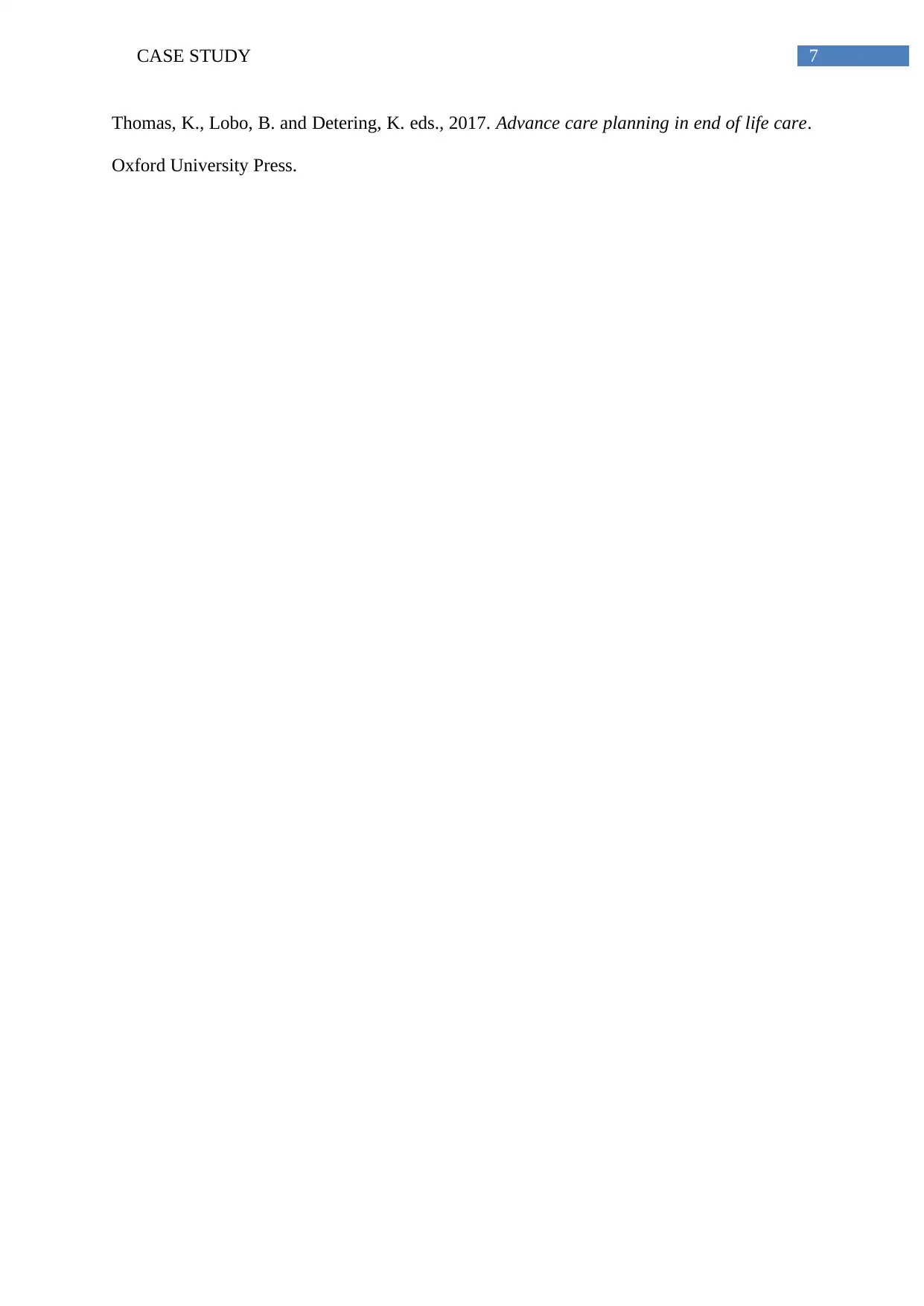
7CASE STUDY
Thomas, K., Lobo, B. and Detering, K. eds., 2017. Advance care planning in end of life care.
Oxford University Press.
Thomas, K., Lobo, B. and Detering, K. eds., 2017. Advance care planning in end of life care.
Oxford University Press.
1 out of 8
Related Documents
Your All-in-One AI-Powered Toolkit for Academic Success.
+13062052269
info@desklib.com
Available 24*7 on WhatsApp / Email
![[object Object]](/_next/static/media/star-bottom.7253800d.svg)
Unlock your academic potential
© 2024 | Zucol Services PVT LTD | All rights reserved.





